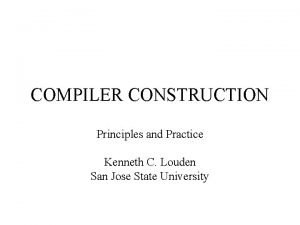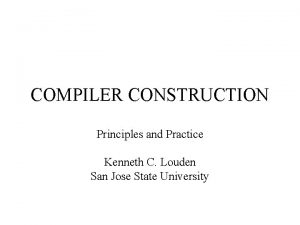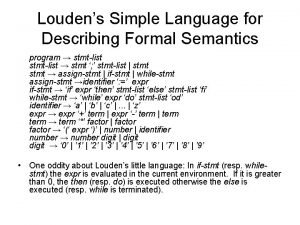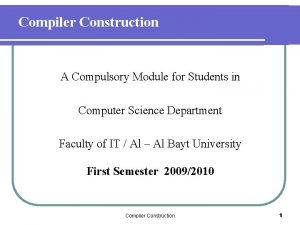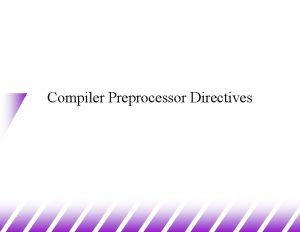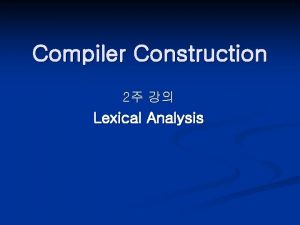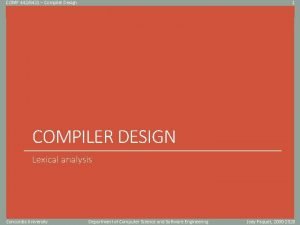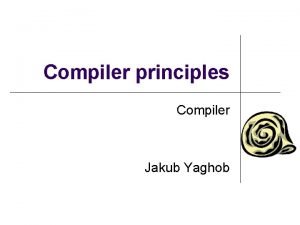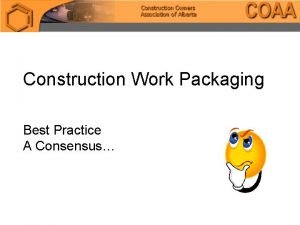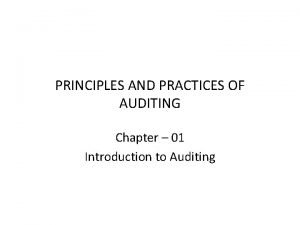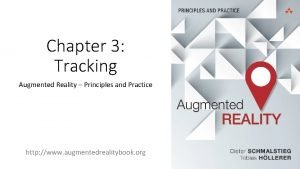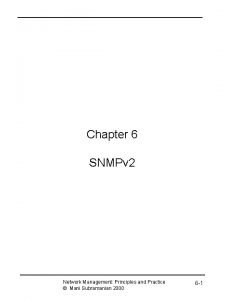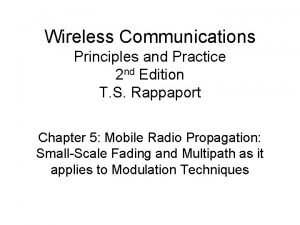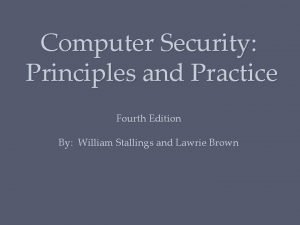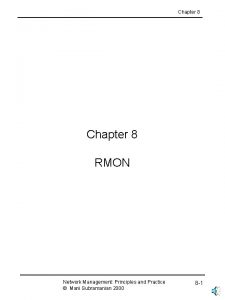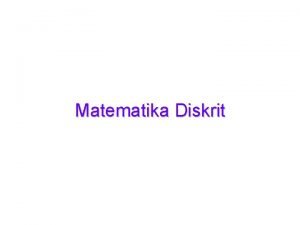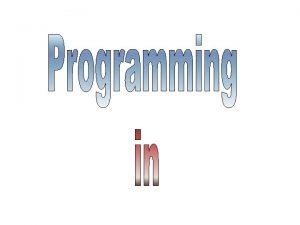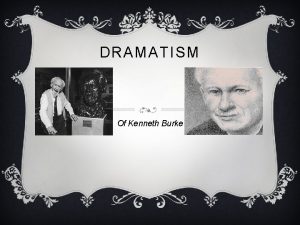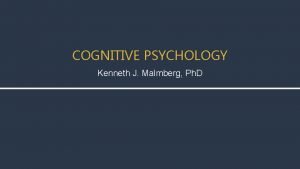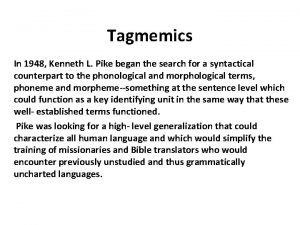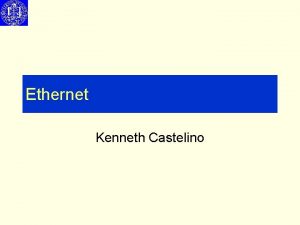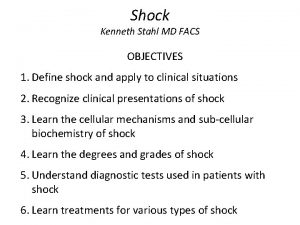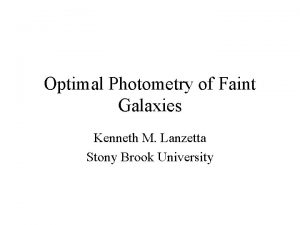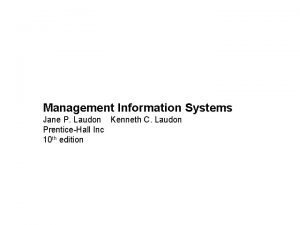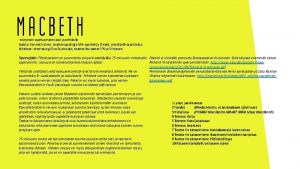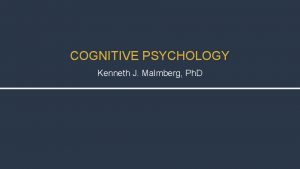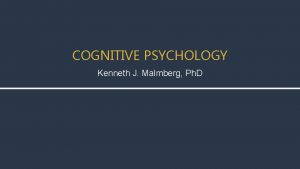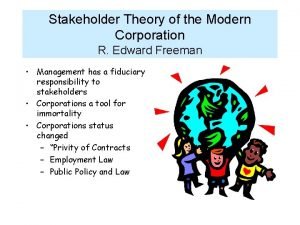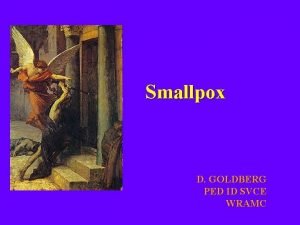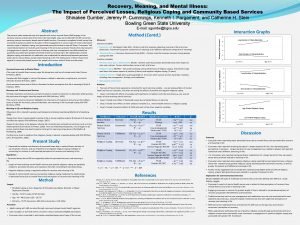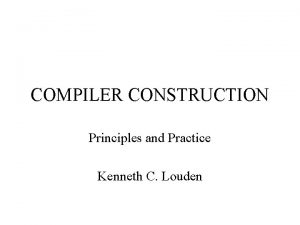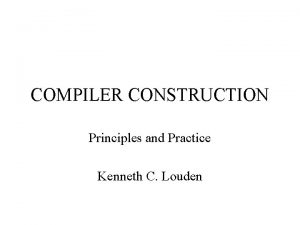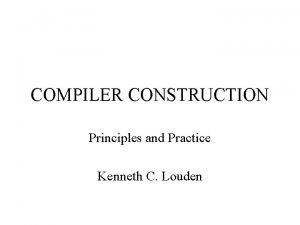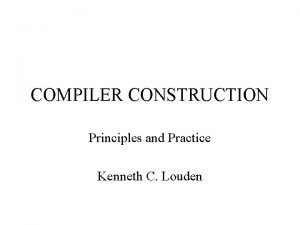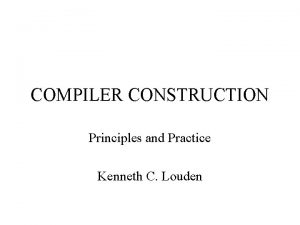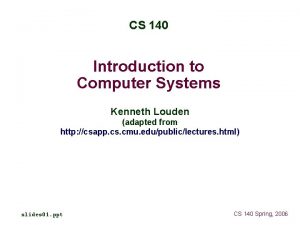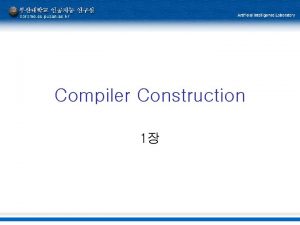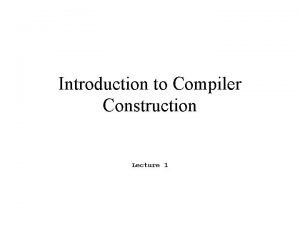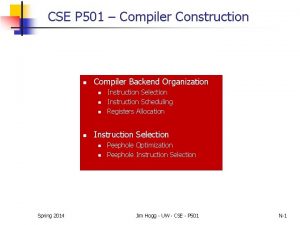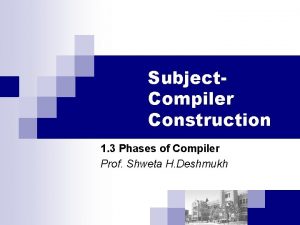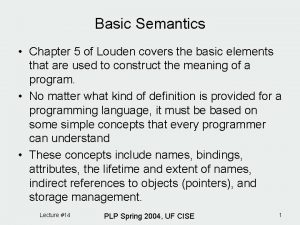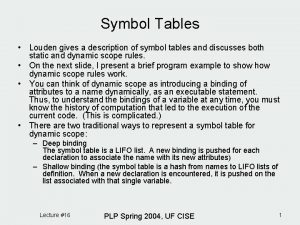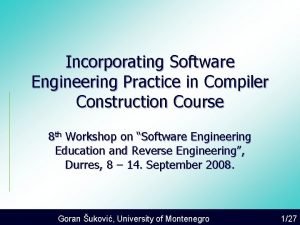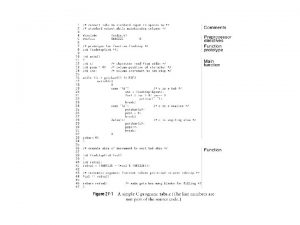COMPILER CONSTRUCTION Principles and Practice Kenneth C Louden


![Contents PART ONE 2. 1 The Scanning Process [Open] 2. 2 Regular Expression [Open] Contents PART ONE 2. 1 The Scanning Process [Open] 2. 2 Regular Expression [Open]](https://slidetodoc.com/presentation_image_h/34766ea73746ebad702c58f1f8a760ec/image-3.jpg)










![More About Regular Expression 2. 2. 1 Definition of Regular Expression [Open] 2. 2. More About Regular Expression 2. 2. 1 Definition of Regular Expression [Open] 2. 2.](https://slidetodoc.com/presentation_image_h/34766ea73746ebad702c58f1f8a760ec/image-14.jpg)

















![Number, Reserved word and Identifiers Numbers – – – nat = [0 9]+ signed. Number, Reserved word and Identifiers Numbers – – – nat = [0 9]+ signed.](https://slidetodoc.com/presentation_image_h/34766ea73746ebad702c58f1f8a760ec/image-32.jpg)






![More About Finite Automata 2. 3. 1 Definition of Deterministic Finite Automata [Open] 2. More About Finite Automata 2. 3. 1 Definition of Deterministic Finite Automata [Open] 2.](https://slidetodoc.com/presentation_image_h/34766ea73746ebad702c58f1f8a760ec/image-39.jpg)





![Examples of DFA Example 2. 8: digit = [0 9] nat = digit + Examples of DFA Example 2. 8: digit = [0 9] nat = digit +](https://slidetodoc.com/presentation_image_h/34766ea73746ebad702c58f1f8a760ec/image-45.jpg)
![Examples of DFA Example 2. 8: digit = [0 9] nat = digit + Examples of DFA Example 2. 8: digit = [0 9] nat = digit +](https://slidetodoc.com/presentation_image_h/34766ea73746ebad702c58f1f8a760ec/image-46.jpg)


























- Slides: 72

COMPILER CONSTRUCTION Principles and Practice Kenneth C. Louden

2. Scanning (Lexical Analysis) PART ONE
![Contents PART ONE 2 1 The Scanning Process Open 2 2 Regular Expression Open Contents PART ONE 2. 1 The Scanning Process [Open] 2. 2 Regular Expression [Open]](https://slidetodoc.com/presentation_image_h/34766ea73746ebad702c58f1f8a760ec/image-3.jpg)
Contents PART ONE 2. 1 The Scanning Process [Open] 2. 2 Regular Expression [Open] 2. 3 Finite Automata [Open] PART TWO 2. 4 From Regular Expressions to DFAs 2. 5 Implementation of a TINY Scanner 2. 6 Use of Lex to Generate a Scanner Automatically

2. 1 The Scanning Process

The Function of a Scanner • Reading characters from the source code and form them into logical units called tokens • Tokens are logical entities defined as an enumerated type – Typedef enum {IF, THEN, ELSE, PLUS, MINUS, NUM, ID, …} Token. Type;

The Categories of Tokens • RESERVED WORDS – Such as IF and THEN, which represent the strings of characters “if” and “then” • SPECIAL SYMBOLS – Such as PLUS and MINUS, which represent the characters “+” and “ “ • OTHER TOKENS – Such as NUM and ID, which represent numbers and identifiers

Relationship between Tokens and its String • The string is called STRING VALUE or LEXEME of token • Some tokens have only one lexeme, such as reserved words • A token may have infinitely many lexemes, such as the token ID

Relationship between Tokens and its String • Any value associated to a token is called an attributes of a token – String value is an example of an attribute. – A NUM token may have a string value such as “ 32767” and actual value 32767 – A PLUS token has the string value “+” as well as arithmetic operation + • The token can be viewed as the collection of all of its attributes – Only need to compute as many attributes as necessary to allow further processing – The numeric value of a NUM token need not compute immediately

Some Practical Issues of the Scanner • One structured data type to collect all the attributes of a token, called a token record – Typedef struct {Token. Type tokenval; char *stringval; int numval; } Token. Record

Some Practical Issues of the Scanner • The scanner returns the token value only and places the other attributes in variables Toke. Type get. Token(void) • As an example of operation of get. Token, consider the following line of C code. A[index] = 4+2 a[ i ndex] = 4 + 2 RET

2. 2 Regular Expression

Some Relative Basic Concepts • Regular expressions – represent patterns of strings of characters. • A regular expression r – completely defined by the set of strings it matches. – The set is called the language of r written as L(r) • The set elements – referred to as symbols • This set of legal symbols – called the alphabet and written as the Greek symbol ∑

Some Relative Basic Concepts • A regular expression r – contains characters from the alphabet, indicating patterns, such a is the character a used as a pattern • A regular expression r – may contain special characters called meta-characters or meta symbols • An escape character can be used to turn off the special meaning of a meta character. – Such as backslash and quotes
![More About Regular Expression 2 2 1 Definition of Regular Expression Open 2 2 More About Regular Expression 2. 2. 1 Definition of Regular Expression [Open] 2. 2.](https://slidetodoc.com/presentation_image_h/34766ea73746ebad702c58f1f8a760ec/image-14.jpg)
More About Regular Expression 2. 2. 1 Definition of Regular Expression [Open] 2. 2. 2 Extension to Regular Expression [Open] 2. 2. 3 Regular Expressions for Programming Language Tokens [Open]

2. 2. 1 Definition of Regular Expressions

Basic Regular Expressions • The single characters from alphabet matching themselves – a matches the character a by writing L(a)={ a } – ε denotes the empty string, by L(ε)={ε} – {} or Φ matches no string at all, by L(Φ)={ }

Regular Expression Operations • • • Choice among alternatives, indicated by the meta character | Concatenation, indicated by juxtaposition Repetition or “closure”, indicated by the meta character *

Choice Among Alternatives • If r and s are regular expressions, then r|s is a regular expression which matches any string that is matched either by r or by s. • In terms of languages, the language r|s is the union of language r and s, or L(r|s)=L(r)UL(s) • A simple example, L(a|b)=L(a)U (b)={a, b} • Choice can be extended to more than one alternative.

Concatenation • If r and s are regular expression, the rs is their concatenation which matches any string that is the concatenation of two strings, the first of which matches r and the second of which matches s. • In term of generated languages, the concatenation set of strings S 1 S 2 is the set of strings of S 1 appended by all the strings of S 2. • A simple example, (a|b)c matches ac and bc • Concatenation can also be extended to more than two regular expressions.

Repetition • The repetition operation of a regular expression, called (Kleene) closure, is written r*, where r is a regular expression. The regular expression r* matches any finite concatenation of strings, each of which matches r. • A simple example, a* matches the strings epsilon, a, aaa, … • In term of generated language, given a set of S of string, S* is a infinite set union, but each element in it is a finite concatenation of string from S

Precedence of Operation and Use of Parentheses • The standard convention Repetition * has highest precedence Concatenation is given the next highest | is given the lowest • A simple example a|bc* is interpreted as a|(b(c*)) • Parentheses is used to indicate a different precedence

Name for regular expression • Give a name to a long regular expression – digit = 0|1|2|3|4……|9 – (0|1|2|3……|9)* digit*

Definition of Regular Expression • A regular expression is one of the following: (1) A basic regular expression, a single legal character a from alphabet ∑, or meta character ε or Φ. (2) The form r|s, where r and s are regular expressions (3) The form rs, where r and s are regular expressions (4) The form r*, where r is a regular expression (5) The form (r), where r is a regular expression • Parentheses do not change the language.

Examples of Regular Expressions Example 1: – – – ∑={ a, b, c} the set of all strings over this alphabet that contain exactly one b. (a|c)*b(a|c)* Example 2: – – ∑={ a, b, c} the set of all strings that contain at most one b. (a|c)*|(a|c)*b(a|c)*(b|ε)(a|c)* the same language may be generated by many different regular expressions.

Examples of Regular Expressions Example 3: – – ∑={ a, b} the set of strings consists of a single b surrounded by the same number of a’s. S = {b, aba, aabaa, aaabaaa, ……} = { anban | n≠ 0} This set can not be described by a regular expression. • – – “regular expression can’t count ” not all sets of strings can be generated by regular expressions. a regular set : a set of strings that is the language for a regular expression is distinguished from other sets.

Examples of Regular Expressions Example 4: – – ∑={ a, b, c} The strings contain no two consecutive b’s ( (a|c)* | (b(a|c))* )* ( (a | c ) | (b( a | c )) )* or (a | c | ba | bc)* • Not yet the correct answer The correct regular expression – – – (a | c | ba | bc)* (b |ε) (a | c | ab| cb )* (not b |b not b)*(b|ε) not b = a|c

Examples of Regular Expressions Example 5: – ∑={ a, b, c} – ((b|c)* a(b|c)*a)* (b|c)* – Determine a concise English description of the language – the strings contain an even number of a’s (nota* a)* nota* BACK

2. 2. 2 Extensions to Regular Expression

List of New Operations 1) one or more repetitions r+ 2) any character period “.” 3) a range of characters [0 9], [a z. A Z]

List of New Operations 4) any character not in a given set (a|b|c) a character not either a or b or c [^abc] in Lex 5) optional sub expressions – r? the strings matched by r are optional BACK

2. 2. 3 Regular Expressions for Programming Language Tokens
![Number Reserved word and Identifiers Numbers nat 0 9 signed Number, Reserved word and Identifiers Numbers – – – nat = [0 9]+ signed.](https://slidetodoc.com/presentation_image_h/34766ea73746ebad702c58f1f8a760ec/image-32.jpg)
Number, Reserved word and Identifiers Numbers – – – nat = [0 9]+ signed. Nat = (+| )? nat number = signed. Nat(“.”nat)? (E signed. Nat)? Reserved Words and Identifiers – – reserved = if | while | do |……… letter = [a z A Z] digit = [0 9] identifier = letter(letter|digit)*

Comments Several forms: { this is a pascal comment } ; this is a schema comment this is an Ada comment {( })*} ( newline)* newline n /* this is a C comment */ can not written as ba(~(ab))*ab, ~ restricted to single character one solution for ~(ab) : b*(a* (a|b)b*)*a* Because of the complexity of regular expression, the comments will be handled by ad hoc methods in actual scanners.

Ambiguity: some strings can be matched by several different regular expressions. – either an identifier or a keyword, keyword interpretation preferred. – a single token or a sequence of several tokens, the single token preferred. ( the principle of longest sub string. )

White Space and Lookahead White space: – – – Delimiters: characters that are unambiguously part of other tokens are delimiters. whitespace = ( newline | blank | tab | comment)+ free format or fixed format Lookahead: – buffering of input characters , marking places for backtracking DO 99 I=1, 10 DO 99 I=1. 10 RET

2. 3 FINITE AUTOMATA

Introduction to Finite Automata • Finite automata (finite state machines) are a mathematical way of describing particular kinds of algorithms. • A strong relationship between finite automata and regular expression • Identifier = letter (letter | digit)* letter 1 2 digit

Introduction to Finite Automata letter 1 • Transition: 2 digit – Record a change from one state to another upon a match of the character or characters by which they are labeled. • Start state: – The recognition process begin – Drawing an unlabeled arrowed line to it coming “from nowhere” • Accepting states: – Represent the end of the recognition process. – Drawing a double line border around the state in the diagram
![More About Finite Automata 2 3 1 Definition of Deterministic Finite Automata Open 2 More About Finite Automata 2. 3. 1 Definition of Deterministic Finite Automata [Open] 2.](https://slidetodoc.com/presentation_image_h/34766ea73746ebad702c58f1f8a760ec/image-39.jpg)
More About Finite Automata 2. 3. 1 Definition of Deterministic Finite Automata [Open] 2. 3. 2 Lookahead, Backtracking , and Nondeterministic Automata [Open] 2. 3. 3 Implementation of Finite Automata in Code [Open]

2. 3. 1 Definition of Deterministic Finite Automata

The Concept of DFA: Automata where the next state is uniquely given by the current state and the current input character. Definition of a DFA: A DFA (Deterministic Finite Automation) M consist of (1) an alphabet ∑, (2) A set of states S, (3) a transition function T : S ×∑ → S, (4) a start state s 0∈S, (5)And a set of accepting states A S

The Concept of DFA The language accepted by a DFA M, written L(M), is defined to be the set of strings of characters c 1 c 2 c 3…. cn with each ci ∈∑ such that there exist states s 1 = t(s 0, c 1), s 2 = t(s 1, c 2), sn = T(sn 1, cn) with sn an element of A (i. e. an accepting state). Accepting state sn means the same thing as the diagram: c 1 c 2 cn s 0 s 1 s 2 ………sn 1 sn

Some differences between definition of DFA and the diagram: letter star t In id digit 1) The definition does not restrict the set of states to numbers 2) We have not labeled the transitions with characters but with names representing a set of characters 3) definitions T: S ×∑ → S , T(s, c) must have a value for every s and c. – – In the diagram, T (start, c) defined only if c is a letter, T(in_id, c) is defined only if c is a letter or a digit. Error transitions are not drawn in the diagram but are simply assumed to always exist.

Examples of DFA Example 2. 6: exactly accept one b Not b b Example 2. 7: at most one b not b b
![Examples of DFA Example 2 8 digit 0 9 nat digit Examples of DFA Example 2. 8: digit = [0 9] nat = digit +](https://slidetodoc.com/presentation_image_h/34766ea73746ebad702c58f1f8a760ec/image-45.jpg)
Examples of DFA Example 2. 8: digit = [0 9] nat = digit + signed. Nat = (+| )? nat Number = singed. Nat(“. ”nat)? (E signed. Nat)? A DFA of nat: digit A DFA of signed. Nat: + digit
![Examples of DFA Example 2 8 digit 0 9 nat digit Examples of DFA Example 2. 8: digit = [0 9] nat = digit +](https://slidetodoc.com/presentation_image_h/34766ea73746ebad702c58f1f8a760ec/image-46.jpg)
Examples of DFA Example 2. 8: digit = [0 9] nat = digit + signed. Nat = (+| )? nat Number = singed. Nat(“. ”nat)? (E signed. Nat)? A DFA of Number: digit + digit - . digit E + digit - digit

Examples of DFA Example 2. 9 : A DFA of C Comments (easy than write down a regular expression) other * 1 / 2 * 3 * 4 / 5 other BACK

2. 3. 2 Lookahead, Backtracking, and Nondeterministic Automata

A Typical Action of DFA Algorithm • • • Making a transition: move the character from the input string to a string that accumulates the characters belonging to a single token (the token string value or lexeme of the token) Reaching an accepting state: return the token just recognized, along with any associated attributes. Reaching an error state: either back up in the input (backtracking) or to generate an error token. letter [other] letter start in_id finish digit return ID

Finite automation for an identifier with delimiter and return value • • The error state represents the fact that either an identifier is not to be recognized (if came from the start state) or a delimiter has been seen and we should now accept and generate an identifier token. [other]: indicate that the delimiting character should be considered look ahead, it should be returned to the input string and not consumed. letter [other] letter start in_id finish digit return ID

Finite automation for an identifier with delimiter and return value • • This diagram also expresses the principle of longest sub string described in Section 2. 2. 4: the DFA continues to match letters and digits (in state in_id) until a delimiter is found. By contrast the old diagram allowed the DFA to accept at any point while reading an identifier string. letter start letter [other] letter in_id finish return ID star t In id digit

How to arrive at the start state in the first place (combine all the tokens into one DFA)

Each of these tokens begins with a different character • Consider the tokens given by the strings : =, <=, and = • Each of these is a fixed string, and DFAs for them can be written as right : = return ASSIGN < = return LE = return EQ = • Uniting all of their start states into a single start state to get the DFA return ASSIGN : < = return LE = return EQ

Several tokens beginning with the same character • They cannot be simply written as the right diagram, since it is not a DFA = return LE < < > return NE < return LT = return LE • The diagram can be rearranged into a DFA < > return NE [other] return LT

Expand the Definition of a Finite Automaton • One solution for the problem is to expand the definition of a finite automaton • More than one transition from a state may exist for a particular character (NFA: non deterministic finite automaton, ) • Developing an algorithm for systematically turning these NFA into DFAs

ε transition • A transition that may occur without consulting the input string (and without consuming any characters) • It may be viewed as a "match" of the empty string. • ( This should not be confused with a match of the characterεin the input)

ε Transitions Used in Two Ways. • First: to express a choice of alternatives in a way without combining states – Advantage: keeping the original automata intact and only adding a new start state to connect them • Second: to explicitly describe a match of the empty string. : = < = =

Definition of NFA • An NFA (non deterministic finite automaton) M consists of – an alphabet , a set of states S, – a transition function T: S x ( U{ε}) ℘(S), – a start state s 0 from S, and a set of accepting states A from S • The language accepted by M, written L(M), – is defined to be the set of strings of characters c 1 c 2…. cn with – each ci from U{ε}such that – there exist states s 1 in T(s 0 , c 1), s 2 in (s 1, c 2), . . . , sn in T(sn-1 , cn) with sn an element of A.

Some Notes • Any of the c. I in c 1 c 2……cn may beε, and the string that is actually accepted is the string c, c 2. . . cn with theε's removed (since the concatenation of s withε is s itself). Thus, the string c, c 2. . . cn may actually have fewer than n characters in it • The sequence of states s 1, . . . , sn are chosen from the sets of states T(s. Q , c 1), . . . , T(sn-1, cn), and this choice will not always be uniquely determined. The sequence of transitions that accepts a particular string is not determined at each step by the state and the next input character. Indeed, arbitrary numbers ofε's can be introduced into the string at any point, corresponding to any number ofε transitions in the NFA.

Some Notes • An NFA does not represent an algorithm. However, it can be simulated by an algorithm that backtracks through every non deterministic choice.

Examples of NFAs Example 2. 10 • The string abb can be accepted by either of the following sequences of transitions: a b ε b → 1→ 2→ 4 a ε ε b → 1→ 3→ 4→ 2→ 4 2 a b a 1 • This NFA accepts the languages as follows: regular expression: (a|ε)b* ab+|ab*|b* • Left DFA accepts the same language. 4 3 a b b b

Examples of NFAs Example 2. 11 • It accepts the string acab by making the following transitions: – (1)(2)(3)a(4)(7)(2)(5)(6)c(7)(2)(3)a(4)(7)(8)(9)b(10) • It accepts the same language as that generated by the regular expression : (a | c) *b a 3 4 1 2 7 c 5 6 8 b 9 10 BACK

2. 3. 3 Implementation of Finite Automata in Code

Ways to Translate a DFA or NFA into Code The code for the DFA accepting identifiers: • • • { starting in state 1 } if the next character is a letter then advance the input; { now in state 2 } while the next character is a letter or a digit do advance the input; { stay in state 2 } end while; { go to state 3 without advancing the input} accept; else { error or other cases } end if; letter 1 [other] 3 2 digit Two drawbacks: • It is ad hoc—that is, each DFA has to be treated slightly differently, and it is difficult to state an algorithm that will translate every DFA to code in this way. • The complexity of the code increases dramatically as the number of states rises or, more specifically, as the number of different states along arbi trary paths rises.

Ways to Translate a DFA or NFA into Code The Code of the DFA that accepts the C comments: • • • • • { state 1 } if the next character is "/" then advance the input; ( state 2 } if the next character is " * " then advance the input; { state 3 } done : = false; while not done do while the next input character is not "*" do advance the input; end while; advance the input; ( state 4 } while the next input character is "*" do advance the input; end while; if the next input character is "/" then done : = true; end if; advance the input; end while; accept; { state 5 } else { other processing } end if; other * 1 / 2 * 3 * 4 / other 5

Ways to Translate a DFA or NFA into Code A better method: • • • Using a variable to maintain the current state and writing the transitions as a doubly nested case statement inside a loop, where the first case statement tests the current state and the nested sec ond level tests the input character. The code of the DFA for identifier: • state : = 1; { start } • while state = 1 or 2 do • case state of • 1: case input character of • letter: advance the input : • state : = 2; • else state : = …. { error or other }; • end case; • 2: case input character of • letter , digit: advance the input; • state : = 2; { actually unnecessary } letter 1 [other] 3 2 digit else state : = 3; • end case; • end while; • if state = 3 then accept else error;

Ways to Translate a DFA or NFA into Code The code of the DFA for C comments • • • • • state : = 1; { start } while state = 1, 2, 3 or 4 do case state of 1: case input character of "/" : advance the input; state : = 2; else state : =. . . { error or other}; end case; 2: case input character of "*": advance the input; state : : = 3; else state : =. . . { error or other }; end case; 3: case input character of "*": advance the input; state : = 4; else advance the input { and stay in state 3 }; end case; • • • 4: case input character of "/" advance the input; state : = 5; "*": advance the input; { and stay in state 4 } else advance the input; state : = 3; end case; end while; if state = 5 then accept else error; * / 1 * 2 * 3 / 4 other 5

Ways to Translate a DFA or NFA into Code Generic code: Express the DFA as a data structure and then write "generic" code; A transition table, or two dimensional array, indexed by state and input character that expresses the values of the transition function T Characters in the alphabet c States s States representing transitions T (s, c)

Ways to Translate a DFA or NFA into Code The transition table of the DFA for identifier: Input char letter digit other Accepting state 1 2 2 2 No 2 [3] 3 no yes Brackets indicate consuming” transitions “noninput Assume : the first state listed is the start state This column indicates accepting states

Ways to translate a DFA or NFA into Code The transition table of the DFA for C comments: Input char / * Other Accepting state 1 2 2 no 3 3 4 3 no 4 5 4 3 no 5 yes The code scheme: • • state : = 1; ch : = next input character; while not Accept[state] and not error(state) do newstate : = T[state, ch]; if Advance[state, ch] then ch : = next input char; state : = newstate; end while; if Accept[state] then accept; Assumes : • • • The transi tions are kept in a transition array T indexed by states and input characters; The transi tions that advance the input (i. e. , those not marked with brackets in the table) are given by the Boolean array Advance, indexed also by states and input characters; Accepting states are given by the Boolean array Accept, indexed by states.

Features of Table Driven Method Table driven: use tables to direct the progress of the algorithm. The advantage: • The size of the code is reduced, the same code will work for many different problems, and the code is easier to change (maintain). The disadvantage: • The tables can become very large, causing a significant increase in the space used by the program. Indeed, much of the space in the arrays we have just described is wasted. • Table driven methods often rely on table compression methods such as sparse array representations, although there is usually a time penalty to be paid for such compression, since table lookup becomes slower. Since scanners must be efficient, these methods are rarely used for them. NFAs can be implemented in similar ways to DFAs, except NFAs are nondeterministic, • there are potentially many different sequences of transitions that must be tried. • A program that simulates an NFA must store up transitions that have not yet been tried and backtrack to them on failure. RET

End of Part One THANKS
 Compiler construction principles and practice
Compiler construction principles and practice Compiler construction principles and practice
Compiler construction principles and practice Loudens
Loudens Yet another compiler compiler
Yet another compiler compiler Cross compiler in compiler design
Cross compiler in compiler design Compiler type checking
Compiler type checking Phases of compiler construction
Phases of compiler construction Explain compiler construction tools
Explain compiler construction tools Front end and back end of compiler
Front end and back end of compiler Preprocessor in compiler construction
Preprocessor in compiler construction Compilers vs interpreters
Compilers vs interpreters Attributes of tokens in compiler design
Attributes of tokens in compiler design Thompson construction in compiler design
Thompson construction in compiler design Compiler
Compiler Construction management standards of practice
Construction management standards of practice Construction work package software
Construction work package software Practice assessor and practice supervisor
Practice assessor and practice supervisor Principle of curriculum
Principle of curriculum Secondary education commission 1952-53
Secondary education commission 1952-53 Fundamental principles of ship construction
Fundamental principles of ship construction Sustainability principles and practice
Sustainability principles and practice Importance of auditing
Importance of auditing Computer security principles and practice 4th edition
Computer security principles and practice 4th edition Computer security principles and practice solutions
Computer security principles and practice solutions Augmented reality: principles and practice
Augmented reality: principles and practice Tourism
Tourism Network management principles and practice
Network management principles and practice Sustainability principles and practice
Sustainability principles and practice Computer security principles and practice 4th edition
Computer security principles and practice 4th edition Telecommunication network management lecture notes
Telecommunication network management lecture notes Wireless communications: principles and practice
Wireless communications: principles and practice Computer security principles and practice
Computer security principles and practice Network management principles and practice
Network management principles and practice Matematika diskrit kenneth rosen pdf
Matematika diskrit kenneth rosen pdf Dr kenneth gorski
Dr kenneth gorski Kenneth nelson sofi
Kenneth nelson sofi Kenneth lane thompson
Kenneth lane thompson Kenneth himma
Kenneth himma Maj. r. mccloughry
Maj. r. mccloughry Ken ott ecommerce
Ken ott ecommerce Dramatism kenneth burke
Dramatism kenneth burke Kenneth malmberg
Kenneth malmberg Dr kenneth wang
Dr kenneth wang Kenneth røn christiansen
Kenneth røn christiansen Tagmemic model ni kenneth pike
Tagmemic model ni kenneth pike Csmscd
Csmscd Sangrado rojo rutilante
Sangrado rojo rutilante Kenneth ellerbee
Kenneth ellerbee Eric bohn md
Eric bohn md Ken sockwell
Ken sockwell Dr kenneth stahl
Dr kenneth stahl Kenneth lanzetta
Kenneth lanzetta Biografia de john kenneth turner
Biografia de john kenneth turner Kenneth c. laudon jane p. laudon
Kenneth c. laudon jane p. laudon Hans kenneth viga-gerhardsen
Hans kenneth viga-gerhardsen Kenneth siren
Kenneth siren Contoh kasus teori dramatisme
Contoh kasus teori dramatisme Kenneth tanabe
Kenneth tanabe Kenneth evans jr
Kenneth evans jr Darwin turvey crowder 1972
Darwin turvey crowder 1972 Kenneth j malmberg
Kenneth j malmberg Kenneth c holmes
Kenneth c holmes When to use messrs in a letter
When to use messrs in a letter Dotter
Dotter Ken wesson
Ken wesson Stakeholder theory of the modern corporation
Stakeholder theory of the modern corporation Que es una neoplasia
Que es una neoplasia Kenneth cusi md
Kenneth cusi md Kenneth turner architect
Kenneth turner architect Kenneth junge
Kenneth junge Goldberg
Goldberg Kenneth nordberg
Kenneth nordberg Kenneth pargament
Kenneth pargament
